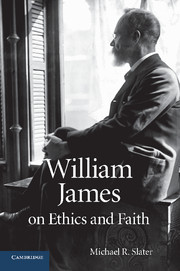Book contents
- Frontmatter
- Contents
- Acknowledgements
- Introduction: a practical faith
- PART I PRACTICAL FAITH AND THE WILL TO BELIEVE
- PART II TWO MORAL ARGUMENTS FOR RELIGIOUS FAITH
- 3 James's religious ethics in “The Moral Philosopher and the Moral Life”
- 4 Overcoming pessimism in “Is Life Worth Living?”
- PART III PIECEMEAL SUPERNATURALISM AND PRACTICAL NEEDS
- Epilogue
- Bibliography
- Index
4 - Overcoming pessimism in “Is Life Worth Living?”
Published online by Cambridge University Press: 03 February 2010
- Frontmatter
- Contents
- Acknowledgements
- Introduction: a practical faith
- PART I PRACTICAL FAITH AND THE WILL TO BELIEVE
- PART II TWO MORAL ARGUMENTS FOR RELIGIOUS FAITH
- 3 James's religious ethics in “The Moral Philosopher and the Moral Life”
- 4 Overcoming pessimism in “Is Life Worth Living?”
- PART III PIECEMEAL SUPERNATURALISM AND PRACTICAL NEEDS
- Epilogue
- Bibliography
- Index
Summary
The therapeutic aspect of James's approach to philosophy is nowhere more evident than in this 1896 essay, where James offers a diagnosis of the symptoms and causes of pessimism and prescribes an essentially philosophical cure. More specifically, he prescribes a religious philosophical cure based upon his will to believe doctrine, arguing that the best way of overcoming the “metaphysical tedium vitae which is peculiar to reflective men” is through the adoption of a practical, non-dogmatic form of religious faith, which he now characterizes in religiously pluralistic terms as faith in an unseen, supernatural order (WB, 39–41; 48–56). As we shall see, James understands this type of pessimism as an essentially religious disease, one made particularly acute today by the advance of scientific knowledge and the erosion of traditional forms of religious belief (WB, 39–41). It consists, he thinks, “in nothing but a religious demand to which there comes no normal religious reply” (WB, 40). Having examined James's account of pessimism and his reasons for thinking that its root causes are religious in nature, we shall then consider yet another Jamesian moral argument for religious faith, one which holds that while belief in an unseen spiritual order is not the only way of overcoming pessimism and despair, it is nonetheless the best way of doing so.
- Type
- Chapter
- Information
- William James on Ethics and Faith , pp. 95 - 110Publisher: Cambridge University PressPrint publication year: 2009



